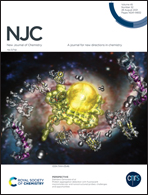Synergism of ultrafine RuCo alloy nanoparticles on graphite carbon nitride for an efficient ammonia borane hydrolysis†
Abstract
Ru-based bimetallic alloy nanoparticles (NPs) have been demonstrated as efficiently catalytic sites for hydrogen evolution from ammonia borane (AB) hydrolysis, but their facile syntheses with ultrafine sizes and superior activity are still challengeable. Herein, we report the in situ fabrication of ultrafine RuCo alloy NPs and concomitant AB hydrolysis using graphite carbon nitride (g-C3N4) as a supporting matrix. Notably, the catalytic activity of Ru1Co1−x/g-C3N4 is mostly dependent on the composition of Ru and Co metals and an optimal synergistic catalysis for AB hydrolysis is achieved using Ru0.1Co0.9/g-C3N4 as a catalyst. An extraordinary turnover frequency of 1260 min−1 is obtained at 25 °C without the use of any basic additives, which surpasses most of the noble metal heterogeneous catalysts. The efficient catalytic activity of Ru0.1Co0.9/g-C3N4 is attributed to the synergistic alloying effect between Ru and Co NPs, and the abundant nitrogen-containing functional groups on g-C3N4 serve as the anchoring sites for ultrafine and uniformly distributed RuCo alloy NPs. The high catalytic activity endows Ru0.1Co0.9/g-C3N4 with desirable potential in hydrogen generation from the hydrolysis of chemical storage materials.



 Please wait while we load your content...
Please wait while we load your content...